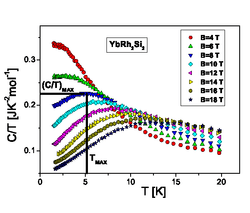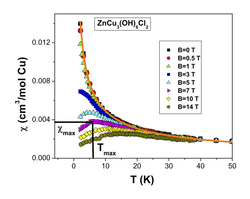Strongly correlated quantum spin liquid
Strongly correlated quantum spin liquid (SCQSL) is a specific realization of a possible quantum spin liquid (QSL)[1][2] representing a new type of strongly correlated electrical insulator (SCI) that possesses properties of heavy fermion metals[3][4] with one exception: it resists the flow of electric charge. At low temperatures T the specific heat of this type of insulator is proportional to Tn with n less or equal 1 rather than n=3, as it should be in the case of a conventional insulator when the heat capacity is proportional to T3. When a magnetic field B is applied to SCI the specific heat depends strongly on B, contrary to conventional insulators. There are a few candidates of SCI; the most promising among them is Herbertsmithite that is a mineral with chemical structure ZnCu3(OH)6Cl2.
Specific properties


Exotic SCQSL’s are formed with such hypothetical particles as fermionic spinons carrying spin 1/2 and no charge. The experimental studies of Herbertsmithite ZnCu3(OH)6Cl2 single crystal have found no evidence of long range magnetic order or spin freezing indicating that Herbertsmithite is the promising system to investigate SCQSL. The planes of the Cu2+ ions can be considered as two-dimensional layers with negligible magnetic interactions along the third dimension. Experiments have found neither long range magnetic order nor glassy spin freezing down to temperature 50 mK[6][8] making Herbertsmithite the best candidate for QSL realization. Frustration of a simple kagome lattice leads to dispersionless topologically protected flat bands.[9][10] In that case fermion condensation quantum phase transition (FCQPT)[11] can be considered as quantum critical point (QCP) of Herbertsmithite. FCQPT creates SCQSL composed of chargeless fermions with spin=1/2 occupying the corresponding Fermi sphere with a finite Fermi momentum. Herbertsmithite's thermodynamic and relaxation properties are similar to those of heavy fermion metals and two-dimensional 3He.[11] The key features of the findings are the presence in Herbertsmithite of spin–charge separation and SCQSL formed with itinerant spinons. Herbertsmithite represents a fascinating example of SCI where particles-spinons, non-existing as free, replace the initial particles appearing in the Hamiltonian and define the thermodynamic and relaxation properties at low temperatures. Because of the spin-charge separation, heat transport, thermodynamic and relaxation properties at low temperatures of the SCI Herbertsmithite are similar to those of heavy-fermion metals rather than of insulators.[7][12]
Fermion condensation quantum phase transition
The experimental facts collected on heavy fermion (HF) metals and two dimensional 3He demonstrate that the quasiparticle effective mass M* is very large, or even diverges.[3][4][13] Fermion condensation quantum phase transition (FCQPT) preserves quasiparticles and is directly related to the unlimited growth of the effective mass M*.[11] Near FCQPT, M* starts to depend on temperature T, density x, magnetic field B and other external parameters such as pressure P etc. In contrast to the Landau paradigm based on the assumption that the effective mass is constant, in the FCQPT theory the effective mass of new quasiparticles strongly depends on T, x, B etc. Therefore, to agree/explain with the numerous experimental facts, extended quasiparticles paradigm based on FCQPT has to be introduced. The main point here is that the well-defined quasiparticles determine the thermodynamic, relaxation, scaling and transport properties of strongly correlated Fermi-systems and M* becomes a function of T, x, B, P etc. The data collected for very different strongly correlated Fermi systems demonstrate universal scaling behavior; in other words distinct materials with strongly correlated fermions unexpectedly turn out to be uniform.[11]
Identification in Experiments
Quantum spin liquid - the new state of matter - is realized in Herbertsmithite, ZnCu3(OD)6Cl2.[14] Magnetic response of this material displays scaling relation in both the bulk ac susceptibility and the low energy dynamic susceptibility, with the low temperature heat capacity strongly depending on magnetic field.[6][15] This scaling is seen in certain quantum antiferromagnets and heavy-fermion metals as a signature of proximity to a quantum critical point. The low-temperature specific heat follows the linear temperature dependence.[6][15] These results suggest that a SCQSL state with essentially gapless excitations is realized in Herbertsmithite.[7][12]
References
- ↑ Balents, L. (2010). "Spin liquids in frustrated magnets". Nature 464 (7286): 199–208. Bibcode:2010Natur.464..199B. doi:10.1038/nature08917. PMID 20220838.
- ↑ Bert, F.; Mendels, P. (2010). "Quantum Kagome antiferromagnet ZnCu3(OH)6Cl2". Journal of the Physical Society of Japan 79: 011001. arXiv:1001.0801. Bibcode:2010JPSJ...79a1001M. doi:10.1143/JPSJ.79.011001.
- ↑ 3.0 3.1 Stewart, G. R. (2001). "Non-Fermi-liquid behavior in d- and f-electron metals". Reviews of Modern Physics 73 (4): 797–855. Bibcode:2001RvMP...73..797S. doi:10.1103/RevModPhys.73.797.
- ↑ 4.0 4.1 Löhneysen, H. V.; Wölfle, P. (2007). "Fermi-liquid instabilities at magnetic quantum phase transitions". Reviews of Modern Physics 79 (3): 1015. arXiv:cond-mat/0606317. Bibcode:2007RvMP...79.1015L. doi:10.1103/RevModPhys.79.1015.
- ↑ Gegenwart, P. et al. (2006). "High-field phase diagram of the heavy-fermion metal YbRh2Si2". New Journal of Physics 8 (9): 171. Bibcode:2006NJPh....8..171G. doi:10.1088/1367-2630/8/9/171.
- ↑ 6.0 6.1 6.2 6.3 Helton, J. S. et al. (2010). "Dynamic Scaling in the Susceptibility of the Spin-1/2 Kagome Lattice Antiferromagnet Herbertsmithite". Physical Review Letters 104 (14): 147201. arXiv:1002.1091. Bibcode:2010PhRvL.104n7201H. doi:10.1103/PhysRevLett.104.147201. PMID 20481955.
- ↑ 7.0 7.1 7.2 Shaginyan, V. R.; Msezane, A.; Popov, K. (2011). "Thermodynamic Properties of Kagome Lattice in ZnCu3(OH)6Cl2 Herbertsmithite". Physical Review B 84 (6): 060401. arXiv:1103.2353. Bibcode:2011PhRvB..84f0401S. doi:10.1103/PhysRevB.84.060401.
- ↑ Helton, J. S. et al. (2007). "Spin Dynamics of the Spin-1/2 Kagome Lattice Antiferromagnet ZnCu3(OH)6Cl2". Physical Review Letters 98 (10): 107204. arXiv:cond-mat/0610539. Bibcode:2007PhRvL..98j7204H. doi:10.1103/PhysRevLett.98.107204. PMID 17358563.
- ↑ Green, D.; Santos, L.; Chamon, C. (2010). "Isolated flat bands and spin-1 conical bands in two-dimensional lattices". Physical Review B 82 (7): 075104. arXiv:1004.0708. Bibcode:2010PhRvB..82g5104G. doi:10.1103/PhysRevB.82.075104.
- ↑ Heikkilä, T. T.; Kopnin, N. B.; Volovik, G. E. (2011). "Flat bands in topological media". JETP Letters 94 (3): 233. arXiv:1012.0905. Bibcode:2011JETPL..94..233H. doi:10.1134/S0021364011150045.
- ↑ 11.0 11.1 11.2 11.3 Shaginyan, V. R.; Amusia, M. Ya.; Msezane, A. Z.; Popov, K. G. (2010). "Scaling Behavior of Heavy Fermion Metals". Physics Reports 492 (2–3): 31. arXiv:1006.2658. Bibcode:2010PhR...492...31S. doi:10.1016/j.physrep.2010.03.001.
- ↑ 12.0 12.1 Shaginyan, V. R. et al. (2012). "Identification of Strongly Correlated Spin Liquid in Herbertsmithite". EPL 97 (5): 56001. arXiv:1111.0179. Bibcode:2012EL.....9756001S. doi:10.1209/0295-5075/97/56001.
- ↑ Coleman, P. (2007). "Heavy Fermions: Electrons at the edge of magnetism". Handbook of Magnetism and Advanced Magnetic Materials. John Wiley & Sons. pp. 95–148. arXiv:cond-mat/0612006.
- ↑ Han, Tian-Heng et al. (2012). "Fractionalized excitations in the spin-liquid state of a kagome-lattice antiferromagnet". Nature 492: 406–410. arXiv:1307.5047. Bibcode:2012Natur.492..406H. doi:10.1038/nature11659.
- ↑ 15.0 15.1 de Vries, M. A. et al. (2008). "The magnetic ground state of an experimental S=1/2 kagomé antiferromagnet". Physical Review Letters 100 (15): 157205. arXiv:0705.0654. Bibcode:2008PhRvL.100o7205D. doi:10.1103/PhysRevLett.100.157205. PMID 18518149.